Candy GVW1585TC3B, GVW1585TC3W Instruction manual
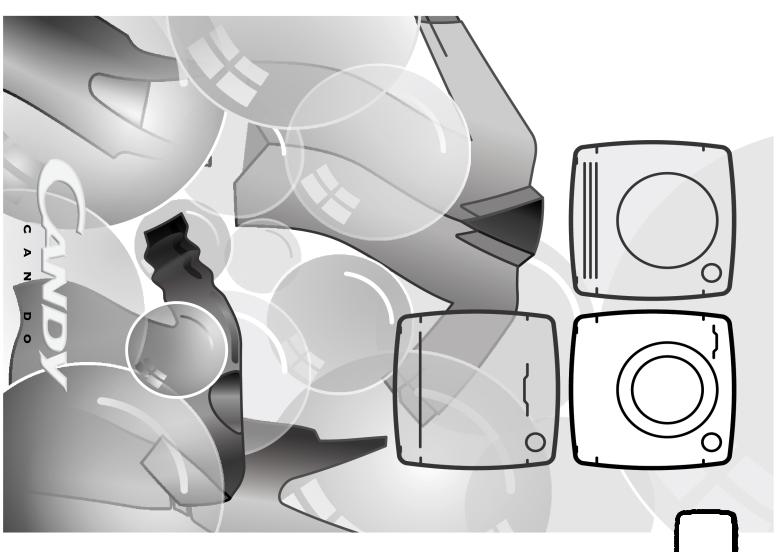
EN

Thank-you for choosing a Candy washing machine. We are confident it will loyally assist you in safely washing your clothes, even delicates, day after day.
You can register your product at www.registercandy.com to gain faster access to supplementary services solely reserved to our most loyal customers.
Carefully read this manual for correct and safe appliance use and for helpful tips on efficient maintenance.
 Only use the washing machine after carefully reading these instructions. We recommend you always keep this manual on hand and in good conditions for any future owners.
Only use the washing machine after carefully reading these instructions. We recommend you always keep this manual on hand and in good conditions for any future owners.
Please check that the appliance is delivered with this instruction manual, warranty certificate, service centre address and energy efficiency label. Also check that plugs, curve for drain hose and liquid detergent or bleach tray (only on some models) are included. We recommend you keep all these components.
Each product is identified by a unique 16character code, also called the “serial number”, printed on the sticker affixed to the appliance (porthole area) or in the document envelope found inside the product. This code is a sort of specific product ID card that you will need to register it and should you need to contact the Candy Customer Service Centre.
Environmental conditions
This appliance is marked according to the European directive 2002/96/EC on Waste Electrical and Electronic Equipment (WEEE).
By ensuring this product is disposed of correctly, you will help prevent potential negative consequences for the environment and human health, which could otherwise be caused by inappropriate waste handling of this product.
The symbol on the product indicates that this product may not be treated as household waste. Instead it shall be handed over to the applicable collection point for the recycling of electrical and electronic equipment.
Disposal must be carried out in accordance with local environmental regulations for waste disposal.
For more detailed information about treatment, recovery and recycling of this product, please contact your local city office, your household waste disposal service or the shop where you purchased the product.
Contents
1.GENERAL SAFETY RULES
2.INSTALLATION
3.PRACTICAL TIPS
4.MAINTENANCE AND CLEANING
5.QUICK USER GUIDE
6.CONTROLS AND PROGRAMS
7.DRYING CYCLE
8.AUTOMATIC WASHING/DRYING CYCLE
9.CUSTOMER SERVICE CENTRE AND WARRANTY
2

1.GENERAL SAFETY RULES
!This appliances is intended to be used in household and similar applications such as:
-Staff kitchen areas in shops, offices and other working environments;
-Farm houses;
-By clients in hotels, motels and other residential type environments;
-Bed and breakfast type environments. A different use of this appliance from household environment or from typical housekeeping functions, as commercial use by expert or trained users, is excluded even in the above applications. If the appliance is used in a manner inconsistent with this it may reduce the life of the appliance and may void the manufacturer’s warranty. Any damage to the appliance or other damage or loss arising through use that is not consistent with domestic or household use (even if located in a domestic or household environment) shall not be accepted by the manufacturer to the fullest extent permitted by law.
!This appliance can be used by children aged from 8 years and above and persons with reduced physical, sensory or mental capabilities or lack of experience and knowledge if they have been given supervision or instruction concerning use of the appliance in a safe way and understand the hazards involved.
Children shall not play with the appliance. Cleaning and user maintenance shall not be made by children without supervision.
!Children should be supervised to ensure that they do not play with the appliance.
!Children of less than 3 years should be kept away unless continuously supervised.
!If the supply cord is damaged, it must be replaced by the manufacturer, its service agent or similarly qualified persons in order to avoid a hazard.
!Only use the hose-sets supplied with the appliance for the water supply connection (do not reuse old hose-sets).
!Water pressure must be between 0,05 MPa and 0,8 MPa.
!Make sure that a carpet do not obstruct the base of the machine and ventilation openings.
!The OFF condition is reached by placing the reference mark on the programmes control/knob in the vertical position. Any other different position of such control sets the machine in ON condition.
!The final part of a washer dryer cycle occurs without heat (cool down cycle) to ensure that the items are left at a temperature that ensures that the items will not be damaged.
EN
3

 WARNING:
WARNING:
never stop a washer dryer before the end of the drying cycle unless all items are quickly removed and spread out so that the heat is dissipated.
!After installation, the appliance must be positioned so that the plug is accessible.
!The appliance must not be installed behind a lockable door, a sliding door or a door with a hinge on the opposite side to that of the washer dryer, in such way that a full opening of the washer dryer door is restricted.
!The maximum load capacity of dry clothes depends on the model used (see control panel).
!The appliance is not to be used if industrial chemicals have been used for cleaning.
!Do not dry unwashed items in the washer dryer.
!Items that have been soiled with substances such as cooking oil, acetone, alcohol, petrol, kerosene, spot removers, turpentine, waxes and wax removers should be washed in hot water with an extra amount of detergent before being dried in the washer dryer.
!Items such as foam rubber (latex foam), shower caps, waterproof textiles, rubber backed articles and clothes or pillows fitted with
foam rubber pads should not be dried in the washer dryer.
!Fabric softeners, or similar products, should be used as specified by the fabric softener instructions.
!Oil-affected items can ignite spontaneously, especially when exposed to heat sources such as a washer dryer. The items become warm, causing an oxidation reaction in the oil, Oxidation creates heat. If the heat cannot escape, items can become hot enough to catch fire. Piling, stacking or storing oil-effected items can prevent heat from escaping and so create a fire hazard.
!If it is unavoidable that fabrics contain vegetable or cooking oil or have been contaminated by hair care products be placed in a washer dryer they should first be washed in hot water with extra detergent - this will reduce, but not eliminate, the hazard.
!Remove all objects from pockets such as lighters and matches.
!To consult the product fiche please refer to the manufacturer website.
Safety instructions
!Before cleaning or maintaining the washing machine, unplug the appliance and turn off the water faucet.
4
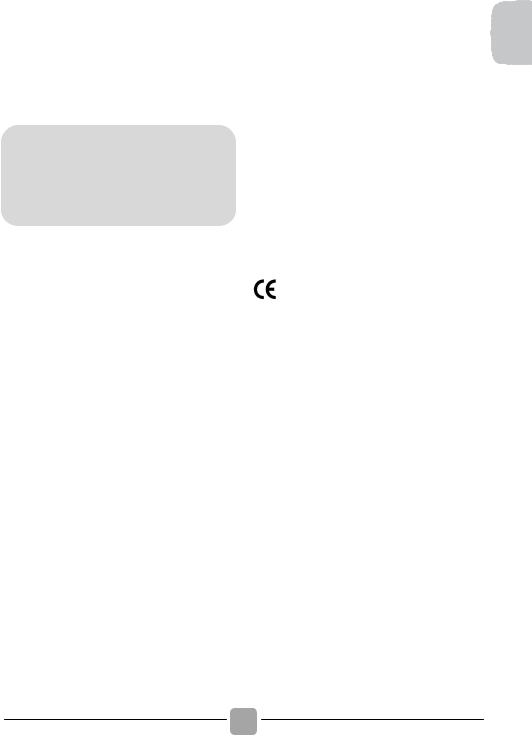
!Make sure the electrical system is grounded. Otherwise, seek qualified professional assistance.
!Please do not use converters, multiple sockets or extension cords.
 WARNING:
WARNING:
water may reach very high temperatures during the wash cycle.
!Make sure there is no water in the drum before opening the porthole.
!Do not pull on the power cord or appliance to unplug the machine.
!Do not expose the washing machine to rain, direct sunlight or other weather elements.
!When moving, do not lift the washing machine by the knobs or detergent drawer; during transport, never rest the porthole on the trolley. We recommend two people lift the washing machine.
!In the event of fault and/or malfunction, turn off the washing machine, close the water faucet and do not tamper with the appliance.
Immediately contact the Customer Service Centre and only use original spare parts. Failure to observe these instruction may jeopardise appliance safety.
Appliance complies with European Directives:
!2006/95/EC (LVD);
!2004/108/EC (EMC);
!2009/125/EC (ErP);
!2011/65/EU (RoHS)
and subsequent amendments.
EN
5
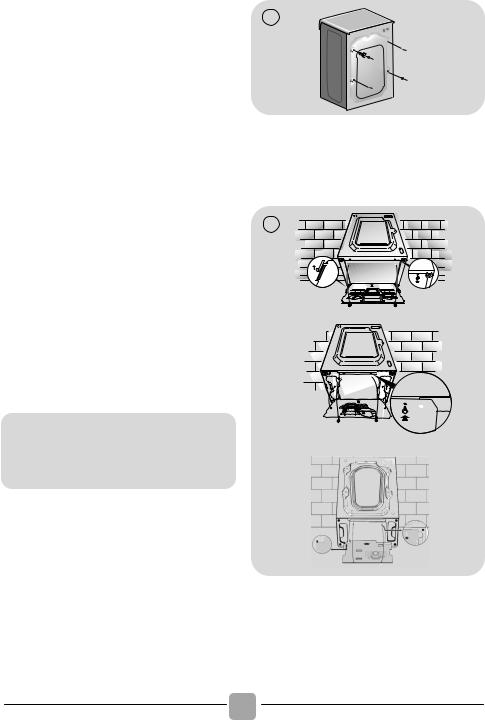
2. INSTALLATION
!Cut the tube straps, being careful not to damage the tube and power cord.
!Unscrew the 2 or 4 screws (A) on the back and remove the 2 or 4 shims (B) as illustrated in figure 1.
!Close the 2 or 4 holes using the plugs included in the instruction envelope.
!If the washing machine is built-in, after cutting the hose straps, unscrew the 3 or 4 screws (A) and remove the 3 or 4 shims (B).
!In some models, 1 or more shims will fall inside the machine: tilt the washing machine forward to remove them. Close the holes using the plugs found in the envelope.
 WARNING:
WARNING:
keep packaging materials away from children.
!Place the polionda sheet on the bottom as shown in figure 2 (according to the model, consider version A, B or C).
6
1
A 
 A
A
BA B A
B B
B
2
A |
|
3 |
|
1 |
2 |
||
|
B
C
3
2 |
1 |
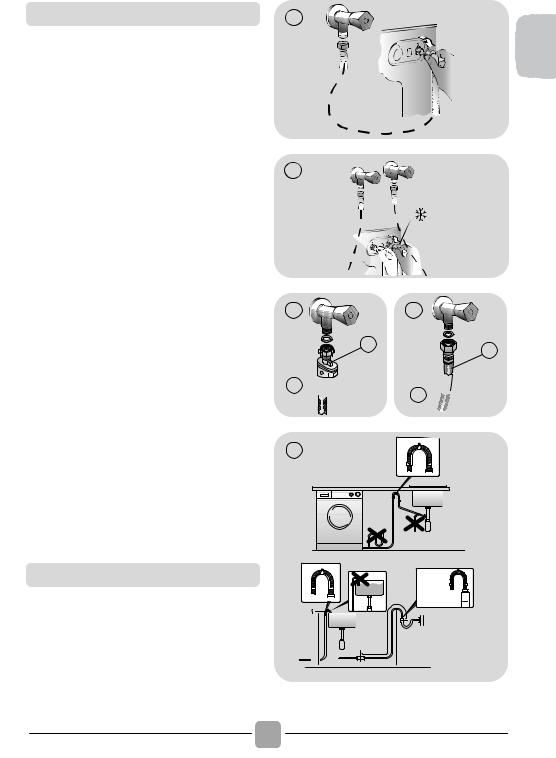
Hydraulic connections
!Connect the water tube to the faucet, only using the drain tube supplied with the washing machine (fig. 3).
DO NOT OPEN THE FAUCET.
!Some models may include one or more of the following features:
!HOT&COLD (fig. 4):
water mains connection settings with hot and cold water for higher energy savings.
Connect the grey tube to the cold water faucet  and the red one to the hot water faucet. The machine can be connected to the cold water faucet only: in this case, some programs may start a few minutes later.
and the red one to the hot water faucet. The machine can be connected to the cold water faucet only: in this case, some programs may start a few minutes later.
!AQUASTOP (fig. 5):
a device located on the supply tube that stops water flow if the tube deteriorates; in this case, a red mark will appear in the window “A” and the tube must be replaced. To unscrew the nut, press the one-way lock device "B".
!AQUAPROTECT – SUPPLY TUBE WITH GUARD (fig. 6):
Should water leak from the primary internal tube "A", the transparent containment sheath "B" will contain water to permit the washing cycle to complete. At the end of the cycle, contact the Customer Service Centre to replace the supply tube.
1
5 |
6 |
B |
B |
|
A 

 A
A 

7
Setting
!Near the washing machine to the wall, being careful that the tube is not bent or crushed, and place the drain tube in the tub or, preferably, connect it to a wall drain at least 50 cm high with diameter greater than the washing machine tube
(fig. 7).
min 4 cm
cm |
|
|
100 |
+2,6 mt |
|
|
|
|
max |
max |
min 50 cm |
|
max 85 cm |
7
EN
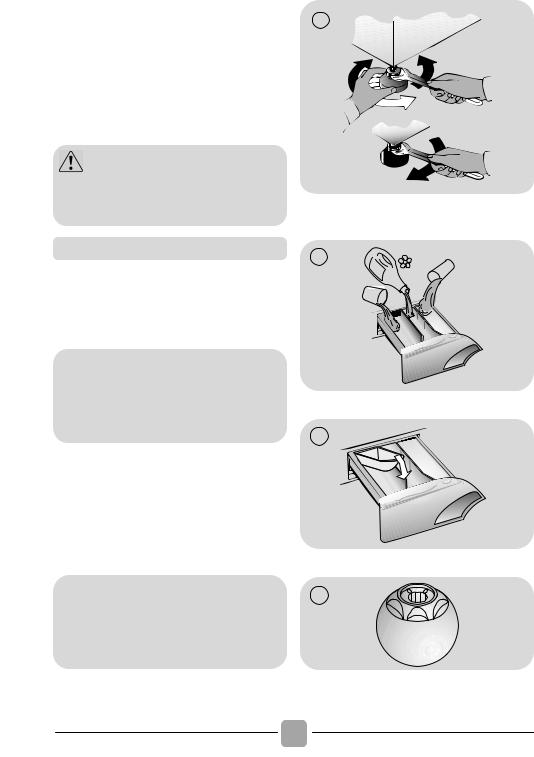
!Level the appliance using the feet as |
8 |
|
|
|
illustrated in figure 8: |
|
|
|
|
a. turn the nut clockwise to release the |
|
|
|
|
screw; |
|
|
|
A |
b. rotate the foot to raise or lower it until it |
|
|
|
|
adheres to the floor; |
|
|
|
|
c. lock the foot, screwing in the nut, until it |
|
|
|
|
adheres to the bottom of the washing |
|
|
|
B |
machine. |
|
|
|
|
!Plug in the appliance. |
|
|
|
|
WARNING: |
|
|
|
|
|
|
|
|
|
|
|
|
|
|
|
C |
|||
contact the Customer Service Centre |
|
|||
should the power cord need |
|
|
|
|
replacement. |
|
|
|
|
Detergent drawer
The detergent draw is split into 3 compartments as illustrated in figure 9:
!compartment "1": for prewash detergent;
!compartment “ ”: for special additives, softeners, starch fragrances, etc.;
”: for special additives, softeners, starch fragrances, etc.;
 WARNING:
WARNING:
only use liquid products; the washing machine is set to automatically dose additives at each cycle during the last rinse.
!compartment "2": for washing detergent.
A liquid detergent cup is also included in some models (fig. 10). To use it, place it in compartment "2". This way, liquid detergent will only enter the drum at the right time. The cup can also be used for bleach when the “Rinse” program is selected.
 WARNING:
WARNING:
some detergents are hard to remove. In this case we recommend using the specific container to be placed in the drum (example in figure 11).
8
9
10
11
1 |
2 |

3. PRACTICAL TIPS
Load tips
WARNING: when sorting laundry, make sure:
-have eliminated metallic objects such as barrettes, pins, coins, from laundry;
-to have buttoned pillow cases, closed zips, tied loose belts and long robe ribbons;
-to have removed rollers from curtains;
-to have carefully read clothing washing labels;
-to have removed any persistent stains using specific detergents.
reduce the necessity of a hot wash programme.
Save up to 50% energy by using a 60°C wash programme.
Before using… a drying programme
!SAVE energy and time by selecting a high spin speed to reduce the water content in laundry before using a drying programme.
Following is a quick guide with tips and recommendations on detergent use at the various temperatures. In any case, always read the instructions on the detergent for correct use and doses.
!When washing rugs, bedcovers or other heavy clothing, we recommend you avoid centrifuging.
!To wash wool, make sure the item can be machine washed and marked by the “Pure virgin wool” symbol with the “Does not mat” or “Machine washable” label.
Helpful suggestions for the user
A guide environmentally friendly and economic use of your appliance.
Maximise The Load Size
!Achieve the best use of energy, water, detergent and time by using the recommended maximum load size.
Save up to 50% energy by washing a full load instead of 2 half loads.
Do you need to pre-wash?
!For heavily soiled laundry only!
SAVE detergent, time, water and between 5 to 15% energy consumption by NOT selecting Prewash for slight to normally soiled laundry.
Is a hot wash required?
!Pretreat stains with stain remover or soak dried in stains in water before washing to
9
When washing heavily soiled whites, we recommend using cotton programs of 60°C or above and a normal washing powder (heavy duty) that contains bleaching agents that at medium/high temperatures provide excellent results.
For washes between 40°C and 60°C the type of detergent used needs to be appropriate for the type of fabric and level of soiling.
Normal powders are suitable for “white” or colour fast fabrics with high soiling, while liquid detergents or “colour protecting” powders are suitable for coloured fabrics with light levels of soiling.
For washing at temperatures below 40°C we recommend the use of liquid detergents or detergents specifically labeled as suitable for low temperature washing.
For washing wool or silk, only use detergents specifically formulated for these fabrics.
EN
